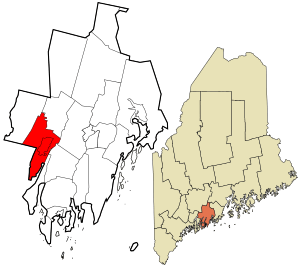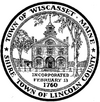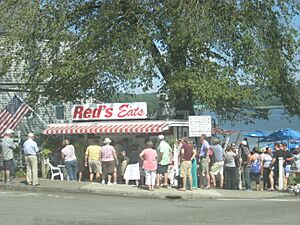Wiscasset, Maine facts for kids
Quick facts for kids
Wiscasset, Maine
|
|||
|---|---|---|---|

Train waiting to depart in Wiscasset
|
|||
|
|||
| Nickname(s):
Maine's Prettiest Village
|
|||

Location in Lincoln County and the state of Maine.
|
|||
| Country | United States | ||
| State | Maine | ||
| County | Lincoln County | ||
| Settled | 1660 | ||
| Incorporated as Pownalborough | February 13, 1760 | ||
| Incorporated as Wiscasset | 1802 | ||
| Government | |||
| • Type | Town Manager - Board of Selectmen | ||
| Area | |||
| • Total | 27.66 sq mi (71.64 km2) | ||
| • Land | 24.63 sq mi (63.79 km2) | ||
| • Water | 3.03 sq mi (7.85 km2) | ||
| Population
(2020)
|
|||
| • Total | 3,742 | ||
| • Density | 152/sq mi (58.7/km2) | ||
| Time zone | UTC-5 (Eastern) | ||
| • Summer (DST) | UTC-4 (Eastern) | ||
| ZIP code |
04578
|
||
| Area code(s) | 207 | ||
Wiscasset is a charming town located in Lincoln County, Maine, United States. It's known as the county seat, which means it's where the main government offices for the county are. You can find Wiscasset in Maine's beautiful Mid Coast region. In 2020, about 3,742 people lived here.
Wiscasset is a popular spot for tourists. People love to visit for its old, beautiful buildings and famous places like Red's Eats restaurant. It's also home to the Chewonki Foundation, an organization focused on outdoor education and environmental studies.
Contents
Wiscasset's Past: A Look at Its History
Early Days and Native American Connections
In 1605, a famous explorer named Samuel de Champlain is believed to have visited this area. He exchanged gifts with the Native Americans who lived here. Europeans first settled Wiscasset in 1660. The town is located on the Sheepscot River, which has tides that go in and out.
The community was left empty during the French and Indian Wars and King Philip's War in 1675. But people returned and resettled around 1730. In 1760, it became an official town called Pownalborough, named after Colonial Governor Thomas Pownall. Later, in 1802, the town went back to its original Abenaki name, Wiscasset. This name means "coming out from the harbor but you don't see where."
Revolutionary War and Protecting the Harbor
During the American Revolutionary War, a British warship called Rainbow stayed in Wiscasset Harbor. It kept the town under control until the town gave the ship important supplies.
In 1775, a story says that Captain Jack Bunker stole the money from a British supply ship, Falmouth Packet, in Wiscasset Harbor. He was chased for days but was caught on Little Seal Island. His treasure is still said to be missing!
Because of the war, Fort Edgecomb was built in 1808. It was placed on the other side of the Sheepscot River to protect Wiscasset's harbor.
A Busy Seaport and Beautiful Buildings
Wiscasset became very successful, and many beautiful buildings were constructed, especially in the Federal style. This was because the seaport was important for privateering, which involved private ships attacking enemy ships during wartime. Today, two of these old homes, Castle Tucker and the Nickels-Sortwell House, are museums run by Historic New England.
The seaport became a hub for shipbuilding, fishing, and lumber. Wiscasset quickly grew into the busiest seaport north of Boston. However, in 1807, a trade ban with England stopped most business, and Wiscasset's trade was severely hurt.
Maine Becomes a State
Maine officially became a state in 1820. This happened with the Missouri Compromise, which also dealt with slavery in new territories. Wiscasset was considered to be the state capital, but it wasn't chosen because it was too close to the ocean.
During the American Civil War, many Wiscasset residents joined the 20th Maine Volunteer Infantry Regiment. This group of soldiers was praised for their bravery at the Battle of Gettysburg.
The Railroad Era in Wiscasset
Train service came to Wiscasset in 1871 with the Knox and Lincoln Railroad. This railroad later joined the Maine Central Railroad in 1901. Before a bridge was built over the Kennebec River in 1927, trains crossed the water using a railroad ferry.
Wiscasset was also the starting point for a special narrow-gauge railway called the Wiscasset, Waterville and Farmington Railway (WW&F). Construction began in 1894, and trains started running in 1895. By 1913, the railroad carried freight and passengers daily, going 43.5 miles north to Albion.
After World War I, more people started using cars and trucks for travel. A man named Frank Winter bought the WW&F railroad around 1930 to move lumber. For a short time in the early 1930s, the WW&F had the last 2-foot gauge railway post office (RPO) in the United States. This meant mail was sorted on the train!
A train accident in 1933 stopped the railroad's operations. Two schooner ships, Hesper and Luther Little, which were meant to carry lumber, were left in Wiscasset. They became famous tourist attractions, visible from the U.S. 1 bridge. After 62 years, their rotted remains were finally removed in 1998.
Famous Local Spots
Red's Eats is a very famous lobster takeout restaurant. It has been located by the Donald E. Davey Bridge on Route 1 since 1954. This small restaurant has been featured in many magazines and TV shows, including USA Today and National Geographic. People sometimes say it causes "the biggest traffic jam in Maine" because so many people stop there!
From 1958 to 1990, Wiscasset was home to the Union Church. The Guinness Book of World Records once called it the world's smallest church. The original church was taken down because it was old, but an exact copy was built at Wiscasset Speedway in April 2024.
In 2009, the town had a legal case about an original copy of the United States Declaration of Independence. The document was accidentally sold from the belongings of a former town official's daughter. A court decided that the true owner was a man who had paid about $475,000 for it in 2002.
Wiscasset's Economy: How People Make a Living
Past Industries
From 1972 to 1996, Wiscasset was home to Maine Yankee, the only nuclear power plant in the state. It was a pressurized water reactor located on Bailey Point. When Maine Yankee closed in 1996, many people lost their jobs. This also led to fewer residents and a drop in school enrollment.
The town tried to replace Maine Yankee with a gasification plant in 2007, but the plan did not go forward after a town vote.
Wiscasset also had the Mason Station, a power plant that used coal and steam. It started operating in 1941 and closed in 1991. There are plans to redevelop this property for offices, light industry, homes, and shops.
New Ideas and Businesses
In 2008, the Chewonki Foundation announced plans for a tidal power plant on the Sheepscot River. This type of plant would use the movement of tides to create electricity. A permit was given in 2009, but the project has not yet started.
Rynel Inc., founded in 1973, makes special materials for medical products. The company was bought by Mölnlycke Health Care in 2010. In 2014, Rynel announced plans to make its Wiscasset factory bigger.
Wiscasset's Location and Weather
Geography: Where Wiscasset Is
Wiscasset covers a total area of about 27.66 square miles (71.64 square kilometers). Most of this is land (24.63 sq mi or 63.79 sq km), and about 3.03 square miles (7.85 sq km) is water. The town is drained by the Sheepscot River.
Climate: Wiscasset's Weather
Wiscasset has a humid continental climate. This means it has big changes in temperature throughout the year. Summers are warm to hot and often humid. Winters are cold, and sometimes very cold.
| Climate data for Wiscasset, Maine (Wiscasset Airport) 1991–2020 normals, extremes 1996–present | |||||||||||||
|---|---|---|---|---|---|---|---|---|---|---|---|---|---|
| Month | Jan | Feb | Mar | Apr | May | Jun | Jul | Aug | Sep | Oct | Nov | Dec | Year |
| Record high °F (°C) | 66 (19) |
62 (17) |
85 (29) |
83 (28) |
94 (34) |
94 (34) |
98 (37) |
95 (35) |
95 (35) |
84 (29) |
73 (23) |
66 (19) |
98 (37) |
| Mean daily maximum °F (°C) | 32.2 (0.1) |
35.0 (1.7) |
42.6 (5.9) |
53.9 (12.2) |
64.8 (18.2) |
73.7 (23.2) |
79.4 (26.3) |
78.6 (25.9) |
70.9 (21.6) |
59.1 (15.1) |
47.9 (8.8) |
37.8 (3.2) |
56.3 (13.5) |
| Daily mean °F (°C) | 22.1 (−5.5) |
24.4 (−4.2) |
32.8 (0.4) |
43.3 (6.3) |
53.6 (12.0) |
62.9 (17.2) |
68.7 (20.4) |
67.6 (19.8) |
60.0 (15.6) |
48.7 (9.3) |
38.7 (3.7) |
28.6 (−1.9) |
45.9 (7.7) |
| Mean daily minimum °F (°C) | 12.1 (−11.1) |
13.8 (−10.1) |
23.0 (−5.0) |
32.7 (0.4) |
42.3 (5.7) |
52.0 (11.1) |
57.9 (14.4) |
56.6 (13.7) |
49.1 (9.5) |
38.4 (3.6) |
29.4 (−1.4) |
19.5 (−6.9) |
35.6 (2.0) |
| Record low °F (°C) | −20 (−29) |
−21 (−29) |
−11 (−24) |
15 (−9) |
27 (−3) |
33 (1) |
45 (7) |
40 (4) |
28 (−2) |
20 (−7) |
4 (−16) |
−17 (−27) |
−21 (−29) |
| Average precipitation inches (mm) | 3.51 (89) |
3.08 (78) |
3.77 (96) |
3.94 (100) |
3.46 (88) |
4.47 (114) |
3.44 (87) |
3.08 (78) |
4.15 (105) |
5.13 (130) |
4.45 (113) |
4.22 (107) |
46.70 (1,186) |
| Average precipitation days (≥ 0.01 in) | 11.6 | 10.5 | 11.2 | 11.7 | 13.3 | 14.2 | 12.7 | 12.7 | 11.8 | 13.2 | 11.9 | 12.3 | 147.1 |
| Source: NOAA | |||||||||||||
People of Wiscasset: Population and Demographics
| Historical population | |||
|---|---|---|---|
| Census | Pop. | %± | |
| 1790 | 2,055 | — | |
| 1800 | 1,678 | −18.3% | |
| 1810 | 2,083 | 24.1% | |
| 1820 | 2,138 | 2.6% | |
| 1830 | 2,255 | 5.5% | |
| 1840 | 2,314 | 2.6% | |
| 1850 | 2,332 | 0.8% | |
| 1860 | 2,318 | −0.6% | |
| 1870 | 1,977 | −14.7% | |
| 1880 | 1,847 | −6.6% | |
| 1890 | 1,733 | −6.2% | |
| 1900 | 1,273 | −26.5% | |
| 1910 | 1,287 | 1.1% | |
| 1920 | 1,192 | −7.4% | |
| 1930 | 1,186 | −0.5% | |
| 1940 | 1,231 | 3.8% | |
| 1950 | 1,584 | 28.7% | |
| 1960 | 1,800 | 13.6% | |
| 1970 | 2,244 | 24.7% | |
| 1980 | 2,832 | 26.2% | |
| 1990 | 3,339 | 17.9% | |
| 2000 | 3,603 | 7.9% | |
| 2010 | 3,732 | 3.6% | |
| 2020 | 3,742 | 0.3% | |
| U.S. Decennial Census | |||
In 2010, there were 3,732 people living in Wiscasset. Most residents (96.8%) were White. About 19.7% of the people were under 18 years old, and the average age in town was 43.5 years.
Places to Visit in Wiscasset
Wiscasset has many interesting places to see, including:
- Captain George Scott House
- Castle Tucker
- Maine Eastern Railroad
- Nickels-Sortwell House
- Red Brick School
- United States Customhouse and Post Office
- Wiscasset Historic District
- Wiscasset Jail and Museum
- Wiscasset Middle High School
- Wiscasset, Waterville and Farmington Railway
Famous People from Wiscasset
Many notable individuals have connections to Wiscasset, including:
- Hugh J. Anderson, a former governor of Maine
- Jeremiah Bailey, a US congressman
- Thomas Bowman, a US congressman
- Mildred Burrage, an artist
- Franklin Clark, a US congressman
- John H. C. Coffin, an astronomer
- Orchard Cook, a US congressman
- Leland Cunningham, an astronomer
- Juliana Hatfield, a musician
- John D. McCrate, a US congressman
- Joseph Ladd Neal, an architect
- Amos Nourse, a US congressman
- Thomas Rice, a US congressman
- Ted Sannella, a dancer
- Joseph Sewall Smith, a Medal of Honor recipient
- Samuel E. Smith, another former governor of Maine
- Richard Hawley Tucker, an astronomer
- Abiel Wood, a US congressman
- Cadwallader C. Washburn, a former governor of Wisconsin
- Charles Ames Washburn, a US minister to Paraguay
- Israel Washburn Jr., a former governor of Maine
- William D. Washburn, a US congressman
Wiscasset in Books
Wiscasset has inspired several authors:
- Author Lea Wait has written a series of children's novels set in Wiscasset. These books include Stopping to Home (set in 1806), Seaward Born (1805), Wintering Well (1820), Finest Kind (1838), and Uncertain Glory (1861).
- Wiscasset is also an important setting in The Moosepath Saga by Van Reid. This series of historical novels takes place in the late 1890s. In these adventure and humor tales, exciting and funny events happen in Wiscasset. For example, there's a hunt for an escaped circus bear and a chase on the Sheepscot River. Some historic homes and landmarks, like the Old Jail, are part of the stories. Some characters, like Sheriff Charles Piper, are even based on real people!
Images for kids
-
Castle Tucker, built 1807
-
Nickels-Sortwell House, built 1807
See also
 In Spanish: Wiscasset (Maine) para niños
In Spanish: Wiscasset (Maine) para niños










